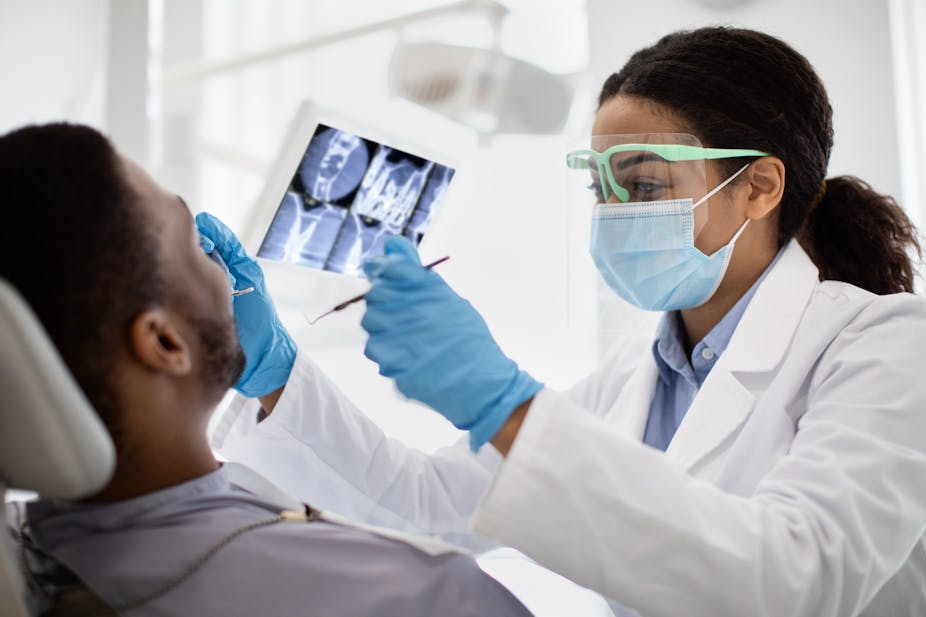Dentistry faces a relatively high risk of exposure to a wide variety of infectious diseases originating from viruses and bacteria present in people’s mouths.
The COVID-19 pandemic (SARS-CoV-2) brought to the forefront the concern of infection spread and transmission in the dental setting, especially since evidence built up about how it’s airborne and transmitted in various environments.
Oral healthcare workers are exposed to disease-causing organisms during dental procedures that generate dental aerosol – the fine mist from saliva, and other fluids, created by the equipment dentists use in patients’ mouths. Water combined with compressed air by equipment such as the fast turbine and ultrasonic scalers during procedures such as fillings and tooth cleanings respectively produces aerosol, droplets and splatter. The cooling liquid of the instrument – usually water – become contaminated in the oral cavity from any organisms in the patient’s mouth and these developed aerosol find their way into the air.
These contaminated aerosols and droplets can remain suspended in the air for extended periods before entering the respiratory tract or settling on surfaces.
The dental practice also has a wide variety of surfaces made from different materials. Effective floor and surface disinfection protocols are essential after every aerosol-generating procedure.
Pre-COVID-19 oral healthcare workers wore some sort of respiratory protection in the form of examination masks, surgical masks or respirators. The COVID-19 pandemic has elevated the additional number of personal protective equipment needed. These now include face shields, protective eye wear, fluid-resistant aprons, mop caps and shoe covers.
It would also be useful to have technologies that reduce aerosol, droplets and splatter to reduce the microbial contamination of the dental environment.
My colleagues and I have invented a novel aerosol suction device. A design patent has been registered and the device was extensively evaluated during 2019/2020. This was done in both laboratory and clinical environments. The device is called the Dental Aerosol Suction Device (DASD). It’s main purpose is to reduce dental aerosols.
When we tested the device, we found it reduced aerosol, droplets and splatter that landed on the oral healthcare workers, compared to existing suction devices. The main advantage of the device is that it functions outside the patient’s mouth. This increases the visual field of view for the oral healthcare worker.
Dental Aerosol Suction Device (DASD):
The device is constructed from a durable chemically resistant and inert medical grade material. It fits in all sterilisers with chambers larger than 20cm(W) x 29cm(L).
The device has a number of advantages.
The first is that its versatile. It can be used in various positions outside the mouth to capture the aerosol, splatter and droplets.
It is also ergonomic and reusable. It can be sterilised in an autoclave. Other suction devices are usually disposable.
The device is also less expensive than other current extra-oral evacuation systems. The DASD doesn’t require any additional electricity and internal filters that require replacement. It’s a simple plug-and-play device. It can go on any dental chair or suction system.
Another advantage is that the device can remove aerosol, droplets and splatter from multiple positions. We recommend it’s positioned 10cm-15cm from the working area. This gives a better view of the mouth compared to high-volume suction that needs to be positioned up to 1cm from the working field.
One extremely important reason the DASD device is so effective is the known routes of transmission of SARS-CoV-2 in humans. This includes contact through oral, nasal and eye mucosal membranes and direct transmission through coughing, sneezing and droplet inhalation.
Studies have demonstrated the presence of SARS-CoV-2 in the aerosol produced during patient exhalation.
A dental dam is used for isolation procedures during various dental procedures like fillings and root canal treatments. A rubber dam is not effective alone for isolation, due to the SARS-CoV-2 virus is present in the patients expelled breath.
During aerosol generation, the conventional 11 millimetre high-volume evacuation canula suction tip only operates for limited time frames during close approximation to the tooth during procedures. Because it needs to be placed in close proximity of the tooth to function optimally it has a reduced efficacy of minimising aerosols exhaled by the patient.
The new devise, on the other hand, has the advantage of a large catchment area and can be placed statically to continuously eliminate aerosols produced during patient exhalation from the 6 O’clock position up to 15 centimetres from the patient’s mouth.
A study showed that aerosols, droplets and splatters have been identified as far as 1.2 metres from the source.
Our study found that the device reduced aerosol, droplets and splatter more than the conventional 11 millimetre high-volume evacuation canula suction tip.
The use of the conventional 11 millimetre high-volume evacuation canula suction tip reduced contamination of the oral healthcare workers by 53% compared to low-volume saliva ejectors alone.
When the DASD was used with the low-volume saliva ejector, our device reduced contamination of the oral healthcare worker’s wrists by 50% and of the chest area by 30%. This was in comparison to the test group where low-volume and high-volume ejectors were used together.

